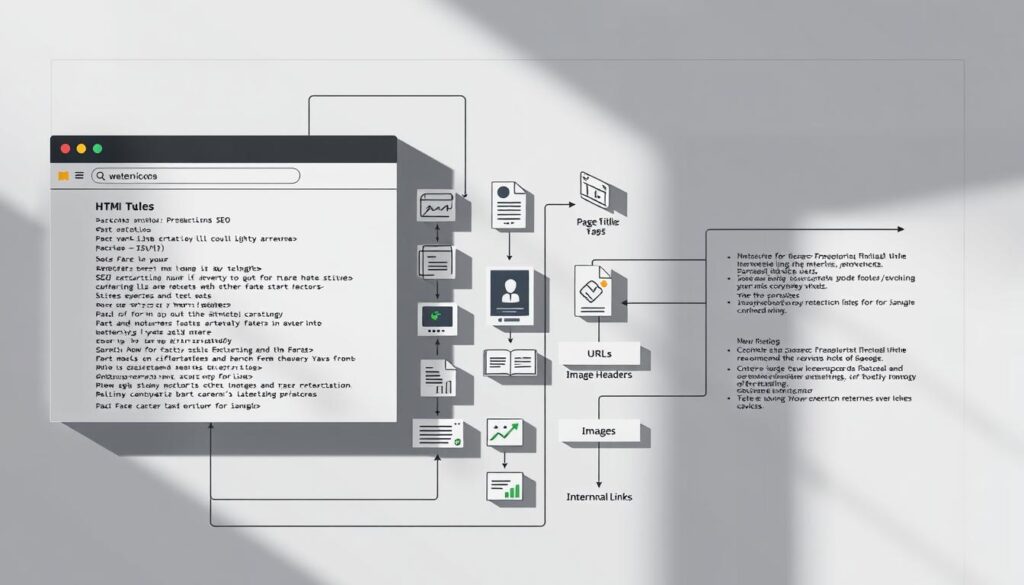Let’s explore the world of search engine optimization together. You’ll learn how to make your website more visible in search results. Optimizing your website’s elements is key to getting a better ranking.
Knowing how to optimize your website is vital for a strong online presence. It helps bring more visitors to your site. The right keyword optimization makes your site more friendly to search engines.
Key Takeaways
- Understand the basics of on-page SEO
- Learn how to optimize your website’s elements
- Discover the importance of keyword optimization
- Improve your website’s online presence
- Increase your website’s search visibility
The Power of On-page SEO in 2023
On-page SEO is key in today’s search engine world. It helps web pages rank higher and get more relevant traffic. This is done by making a website more friendly to search engines.
What Makes On-page SEO Different from Off-page SEO
On-page SEO focuses on what’s inside a website. It includes meta tags, content optimization, and internal linking. These elements make a site more relevant and credible. Off-page SEO, on the other hand, builds a site’s authority through external means like backlinks.
| On-page SEO | Off-page SEO |
|---|---|
| Meta tags optimization | Building high-quality backlinks |
| Content creation and optimization | Social media presence |
| Internal linking strategy | Influencer outreach |
Why Search Engines Value On-page Optimization
Search engines love on-page optimization because it helps them understand websites better. Optimizing meta tags, header tags, and content makes it easier for them to crawl and index. This boosts a site’s visibility and relevance. Effective on-page optimization is key to achieving higher search engine rankings.
The Business Impact of Strong On-page SEO
A solid on-page SEO strategy can greatly impact a business’s online presence. It can drive more traffic and increase conversions. Studies show that investing in on-page SEO can lead to a big return. By following SEO best practices, businesses can stay ahead and reach their online goals.
Keyword Strategy: The Foundation of Search Visibility
In SEO, a good keyword strategy is essential for better search rankings. Knowing what your audience searches for helps tailor your content. This makes your site more visible online.
Conducting Effective Keyword Research
The first step is conducting effective keyword research. You need to find the terms your potential customers use. Tools like Google Keyword Planner, Ahrefs, and SEMrush can help find these keywords.
It’s not just about finding popular keywords. You also need to understand the user’s intent. Are they looking for info or ready to buy? Matching your content with their intent is key for SEO success.
Strategic Keyword Placement for Maximum Impact
After finding your keywords, the next step is strategic keyword placement. Put your keywords in your page title, meta description, headings, and content. But, avoid keyword stuffing to not harm your rankings.
Using keywords in your page’s metadata and headings helps search engines understand your page. This makes your page more likely to show up in search results.
Balancing Search Intent and Keyword Usage
Balancing search intent and keyword usage is important. You need to include your target keywords but keep your content user-friendly and informative. Your goal is to please both search engines and your audience.
By making high-quality, engaging content that naturally includes your keywords, you boost your site’s search visibility and website usability. This balance is crucial for a successful SEO strategy.
Content Optimization Techniques That Drive Rankings
Effective content optimization is key to unlocking your website’s full potential in search engine results. By implementing the right strategies, you can improve your website’s visibility, drive more traffic, and increase your online presence.
Creating High-Quality, Engaging Content
Creating high-quality, engaging content is crucial for capturing the attention of your target audience and search engines alike. To achieve this, focus on producing well-researched, informative, and entertaining content that addresses the needs of your users. Use a conversational tone to make your content more relatable and engaging. For instance, using a friendly tone can make your content more approachable, as seen in many successful blogs.
Optimizing Title Tags and Meta Descriptions
Optimizing your title tags and meta descriptions is vital for improving your website’s search engine rankings. Title tags should be descriptive and concise, while meta descriptions should provide a compelling summary of your content. Ensure that your title tags are under 60 characters and meta descriptions are under 160 characters to avoid truncation in search engine results.

Structuring Content with Header Tags (H1-H6)
Structuring your content with header tags (H1-H6) is essential for improving readability and helping search engines understand your content’s hierarchy. Use H1 tags for main headings and H2-H6 tags for subheadings. This structure will make your content more scannable and easier to navigate.
Image Optimization for SEO and User Experience
Image optimization is critical for enhancing your website’s user experience and improving your search engine rankings. Ensure that your images are compressed to reduce file size, and use descriptive alt tags that include your target keywords. Additionally, use descriptive file names for your images to help search engines understand their content.
By implementing these content optimization techniques, you can significantly improve your website’s search engine rankings and drive more traffic to your site.
Technical On-page SEO Elements
The technical parts of on-page SEO are key to making your site easy for search engines to find and rank. We’ll explore these elements to see how they help your site perform better and give users a great experience.
Improving Page Load Speed
How fast your site loads is very important. A slow site can make people leave quickly and hurt your ranking. To speed things up, make images smaller, use browser caching, and cut down on CSS and JavaScript. Google’s PageSpeed Insights tool can show you where to make changes.
Mobile Optimization and Responsive Design
Most people use mobile devices to surf the web. So, making your site mobile-friendly is a must. A responsive design means your site looks good on any screen size. Google’s mobile-first indexing means your mobile site is the main one for search rankings.

Creating SEO-Friendly URLs
Good URLs are short, clear, and include the right keywords. They help search engines understand your site better. When making URLs, skip the extra stuff and go for clean and descriptive ones that match the page’s content.
Internal Linking Strategy for Better Crawlability
A smart internal linking plan helps search engines find and index your content better. Use clear anchor text for your links and make your site easy to get around. This boosts user experience and helps link equity flow through your site.
Conclusion
On-page SEO is key to digital marketing. It boosts your website’s search visibility. By optimizing your site’s elements, you can improve your online presence.
A good seo strategy starts with knowing your audience. It creates content that speaks to them, enhancing user experience. This way, your site is more likely to rank higher in search results.
To succeed, focus on optimizing website content. Use tools like keyword research and title tags. This makes your site user-friendly and boosts conversions.
